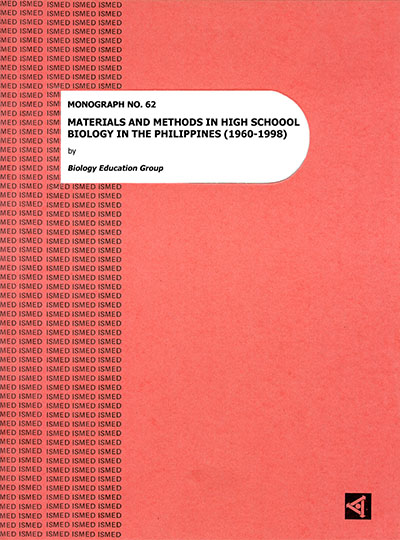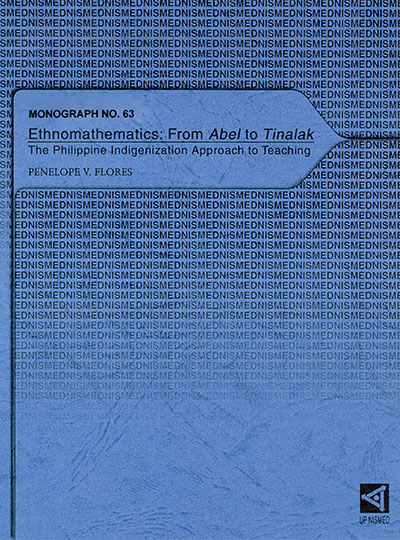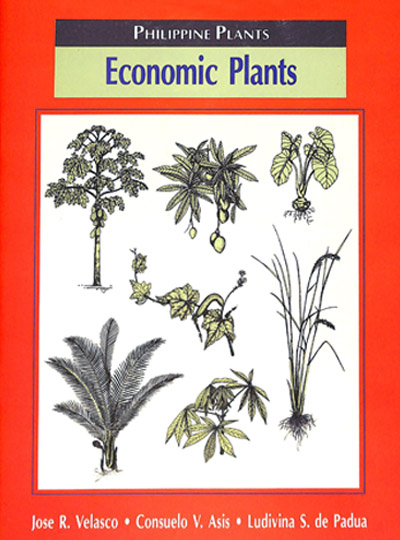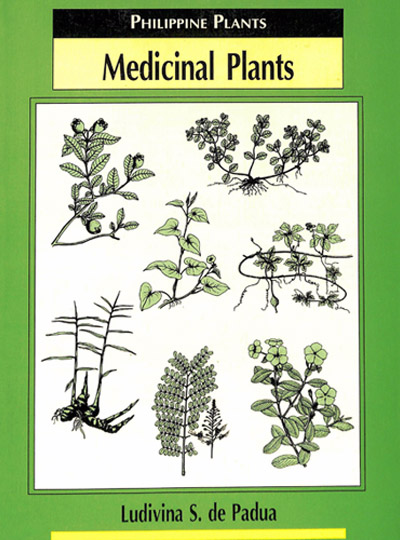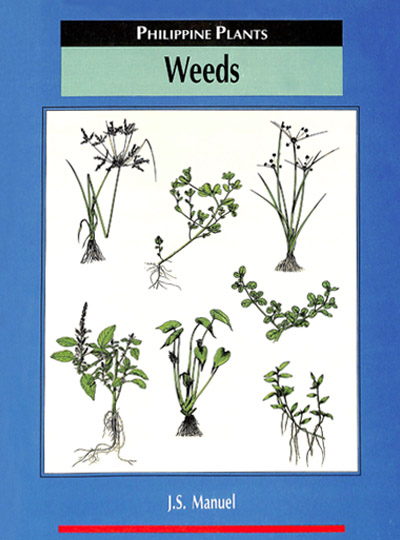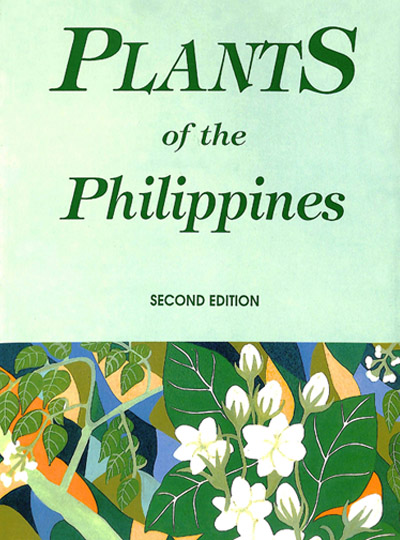-

Research and Development Team ISBN 971-570-081-0 Published by NISMED June 2001
No of Pages: 173
____________
This book traces the development of Philippine science and mathematics education and its changing roles in pursuit of national goals from 1898 to 1998. Significant events and contributions, including anecdotal records, at the basic and teacher education level, are presented.
The book presents the century in four quarters as follow:
-
Science and Mathematics education under American rule
-
Vocation-oriented science and mathematics education
-
Science and mathematics education reforms
-
Institutionalizing science and mathematics education program
-
-
 Pupils’ Activities and Teaching Guide Lourdes R. Carale ISBN 971-570-132-9 Published by NISMED January 2006 No. of Pages: 36 ____________ These teacher material and pupils' activities on the circulatory system were developed under the Science and Mathematics Education Manpower Development Project (SMEMDP) sponsored by the Japan International Cooperation Agency (JICA). They have been tried out in countless teacher training programs, and also with children in connection with a research project, reviewed by experts with regard to accuracy of content, and revised for classroom use.
Pupils’ Activities and Teaching Guide Lourdes R. Carale ISBN 971-570-132-9 Published by NISMED January 2006 No. of Pages: 36 ____________ These teacher material and pupils' activities on the circulatory system were developed under the Science and Mathematics Education Manpower Development Project (SMEMDP) sponsored by the Japan International Cooperation Agency (JICA). They have been tried out in countless teacher training programs, and also with children in connection with a research project, reviewed by experts with regard to accuracy of content, and revised for classroom use. -
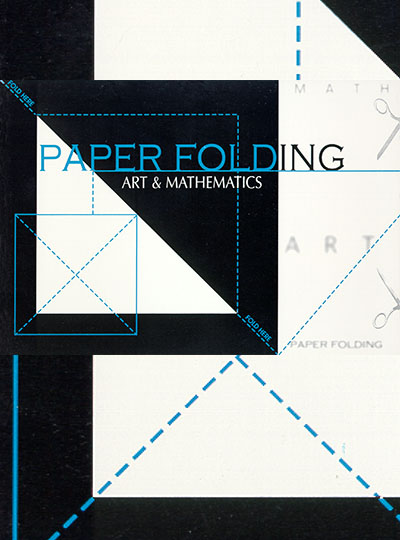 Paper Folding: Art and Mathematics Josefina C. Fonacier, et. al. ISBN 971-570-087-X Published by the NISMED March 2000 No of Pages: 53 ____________ This resource introduces or applies geometry in a setting that is less formal and more visual and tactile and hence, more interesting and learnable for secondary students and teachers. Lessons in paper folding, or origami, provide the learners with experiences to create and manipulate basic geometric shapes in the hope that, in the process, they discover relationships. Every activity is well illustrated and is followed by a discussion, an explanation for why the paper folding activity works, and a section on “Further Discussion and Problems.”
Paper Folding: Art and Mathematics Josefina C. Fonacier, et. al. ISBN 971-570-087-X Published by the NISMED March 2000 No of Pages: 53 ____________ This resource introduces or applies geometry in a setting that is less formal and more visual and tactile and hence, more interesting and learnable for secondary students and teachers. Lessons in paper folding, or origami, provide the learners with experiences to create and manipulate basic geometric shapes in the hope that, in the process, they discover relationships. Every activity is well illustrated and is followed by a discussion, an explanation for why the paper folding activity works, and a section on “Further Discussion and Problems.” -
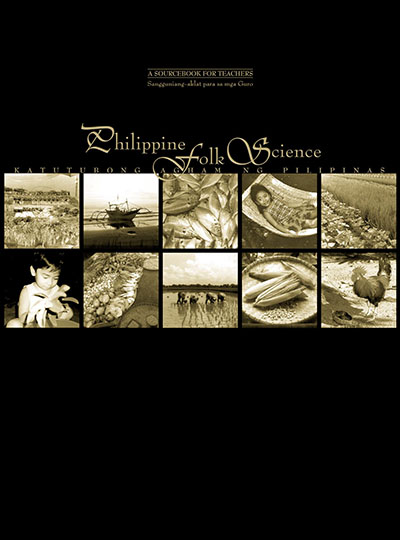 Research and Development Team ISBN 971-570-065-9 Published by NISMED July 2000 with Filipino Translation ₱ 210.00 No. of Pages: 104 English Version Only ₱ 150.00 No. of Pages: 104 __________ A research commissioned by the UP NISMED and conducted by Dr. F. Landa Jocano in 1978-1980 lists the beliefs and practices in most regions of the country. Some of these beliefs and practices, especially in agriculture, fishing, food and nutrition, and medicine are science-related. The Philippine Folk Science provides scientific explanations for these belief and practices. A few beliefs/practices included in the sourcebook are not found in Jocano’s list. These were generated from the interviews conducted by the Research and Development Team. This sourcebook, written in English with parallel Filipino translation, aims to relate science to daily life so that readers can learn concepts in a more relevant context.
Research and Development Team ISBN 971-570-065-9 Published by NISMED July 2000 with Filipino Translation ₱ 210.00 No. of Pages: 104 English Version Only ₱ 150.00 No. of Pages: 104 __________ A research commissioned by the UP NISMED and conducted by Dr. F. Landa Jocano in 1978-1980 lists the beliefs and practices in most regions of the country. Some of these beliefs and practices, especially in agriculture, fishing, food and nutrition, and medicine are science-related. The Philippine Folk Science provides scientific explanations for these belief and practices. A few beliefs/practices included in the sourcebook are not found in Jocano’s list. These were generated from the interviews conducted by the Research and Development Team. This sourcebook, written in English with parallel Filipino translation, aims to relate science to daily life so that readers can learn concepts in a more relevant context. -
 Josefina G. Belen (Ed.) ISSN 0119-6928 Published by NISMED November 1999
Josefina G. Belen (Ed.) ISSN 0119-6928 Published by NISMED November 1999No of Pages: 116
____________
The Philippine Science and Mathematics Education Studies is a biannual journal that considers for publication original articles in all fields of science and mathematics education. The journal publishes research reports and accounts of how an innovation was developed combined with an evaluation of its success or failure in practice.

